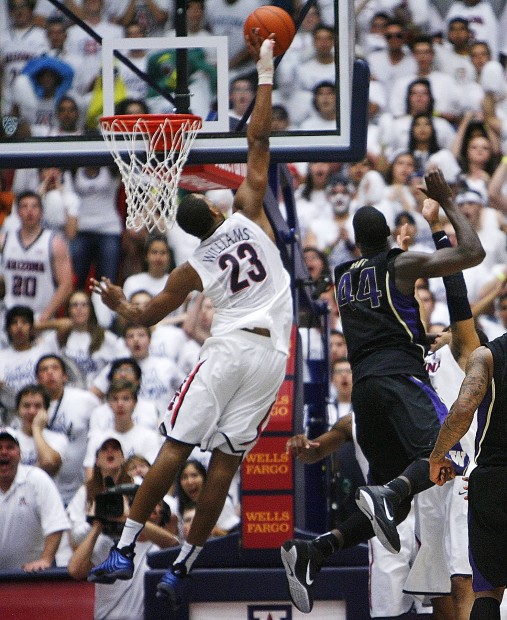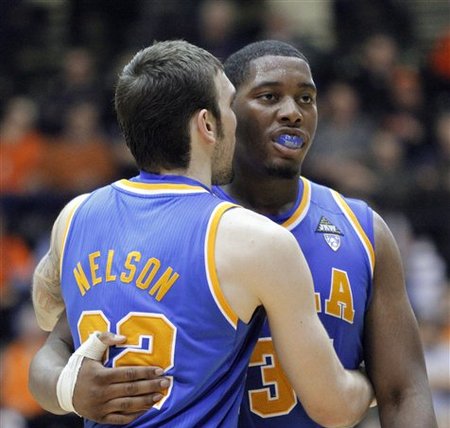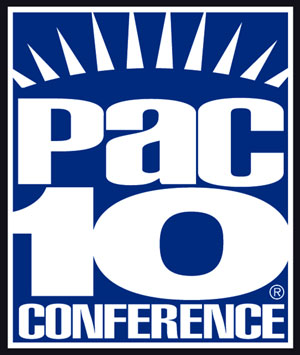Conference Report Card: Pac-10
Posted by Brian Goodman on April 13th, 2011Andrew Murawa is the RTC correspondent for the Pac-10 and Mountain West conferences. We will be publishing a series of conference report cards over the next week for conferences that received multiple NCAA bids to recap the conference, grade the teams, and look at the future for the conference.
Conference Recap:
After an awful 2009-10 season in which the Pac-10 had to limp into a second NCAA Tournament bid when Washington hit the gas pedal down the stretch, the four tournament bids the conference received this year was a huge improvement. With Arizona advancing to the Elite Eight, the Pac-10 advanced a team beyond the Sweet 16 for the first time in three seasons, and the conference was a much deeper collection of teams than last year. And without a doubt, that came as a result of the enhanced talent level across the conference. Coming into the season, there were just 17 seniors on rosters across the conference, and the youngsters showed vast improvement this year, notably Derrick Williams (an All-American and national player of the year candidate), Isaiah Thomas, Tyler Honeycutt, and Klay Thompson with several other players making big strides in their games. While the Pac-10 still struggled to gain national respect, it was clear to fans that the level of play is on the rebound from its 2009-2010 nadir.

The Pac-10 was Derrick Williams' personal playground in 2011, and the Wildcats displayed perhaps the most impressive performance of the NCAA Tournament in their dismantling of Duke. (AZ Daily Star/M. Popat)
Team-by-Team Rankings, By Grade:
- Arizona (30-8, 14-4): Last year the Wildcats went 16-15 and failed to be invited to the NCAA Tournament for the first time in 25 years. Sean Miller, Derrick Williams, and a host of effective role players made sure that the 09-10 downturn was little more than a blip on the radar, as Williams was spectacular in helping Arizona to a regular season Pac-10 title and to within one play of a Final Four appearance. While the future appears blindingly bright in Tucson again, the big immediate question revolves around whether Williams will head to the NBA this summer. His most recent comments indicate that he is still undecided, and there is no reason not to take him at his word, but the fact is he would be a very high lottery pick should he leave and Miller and company would be wise to begin planning for life after Williams. Guys like Momo Jones, Kyle Fogg, Kevin Parrom, Solomon Hill, and Jesse Perry have already proven their worth, and incoming freshmen like Nick Johnson, Josiah Turner, Angelo Chol, and Sidiki Johnson will make an already insanely deep Wildcat team deeper still, meaning that if there is a team in the country able to absorb the potential early loss of a player the caliber of Williams and move on with barely a stumble, it is this Arizona team. Great season for the Wildcats, and Miller has laid the groundwork for future great seasons in the desert. GRADE: A
- UCLA (23-11, 13-5): Normally, an 11-loss season that ends on the first weekend of the NCAA Tournament in a feeble effort against a beatable higher seed does not earn a grade this high around Westwood. However, given the depths to which the Bruin program plunged last year, the B+ I’m giving Ben Howland‘s team is a well-earned score. UCLA weathered an early-season four-game losing streak (capped by an inexplicable loss at home to Montana days after they took Kansas to the wire in Lawrence), bounced back from a 1-2 start in conference play, and played solid (if unspectacular and at times wildly inconsistent) ball through the vast majority of the final ten weeks of the season. Guys who failed to live up to their potential last season came to life this year with Reeves Nelson, Tyler Honeycutt, and Malcolm Lee all having stretches of superb play. Even junior point guard Jerime Anderson, widely reviled among Bruin fans for his struggles in his first two seasons after being a four-star recruit, showed flashes of competence and leadership. And freshman big man Joshua Smith lived up to, and exceeded, his lofty expectations. While Honeycutt and Lee have already put their names into the NBA Draft, the Bruins have North Carolina transfers David and Travis Wear eligible next season and freshman off-guard Norman Powell ready to step in for some early minutes. As the Bruins turn into the Southern California traveling college basketball team next season as Pauley Pavilion undergoes renovation, a combination of Smith, Nelson, and the newcomers could make for a formidable core of players. GRADE: B+
- Cal (18-15, 10-8): Given that the Bears only returned two players who played more than seven minutes per game in 2009-2010, what Mike Montgomery and his club accomplished in Berkeley this year was laudable. After freshman guard Gary Franklin abruptly transferred following their conference opening loss to Stanford, fellow freshman guard Allen Crabbe exploded onto the scene, averaging 17 points per game the rest of the regular season, despite suffering a concussion and missing two entire games, plus most of a third. Junior guard Jorge Gutierrez also took a huge leap forward this season, leading the team in scoring, assists, and steals, not to mention floor burns and annoyed opponents. Up front junior Harper Kamp and senior Markhuri Sanders-Frison combined to form an imposing frontcourt, and, were it not for a four-game slide coinciding with Crabbe’s concussion, the Bears could have earned their way back into the bubble picture. With only Sanders-Frison graduating, Cal could be a force to be reckoned with next year, especially if Montgomery can get some offseason improvement out of lanky 6’10″ freshman Richard Solomon. GRADE: B-
- Oregon (21-18, 7-11): For a team that came into the season with zero expectations, with their five-man (Joevan Catron) a 6’6″ grinder coming off of a season that ended with injury and a 6’6″ shooting guard (E.J. Singler) relegated to playing power forward, a 21-18 record is astounding. The fact that Dana Altman was able to wrap up his first season in Eugene by winning the CBI postseason tournament against his previous school, Creighton, is just gravy. Along the way, the Ducks successfully opened their sparkling new Matthew Knight Arena, posted wins over UCLA, Washington, Washington State, and a couple over USC, and swept their in-state rival, this was a pretty darn successful season for a program that was starting over from almost nothing. Throw in the fact that Altman has signed four-star shooting guard Jabari Brown, along with a handful of other prospects that should give Oregon a significant talent infusion next season and Duck fans have to be ecstatic with their hire. GRADE: B
- USC (19-15, 10-8): It was a wildly divergent season for the Trojans. This was a team capable of whooping Texas, beating Tennessee on the road, hanging with Kansas in Allen Fieldhouse to the final possession, and smacking around Arizona in conference, but this was also a team that could lose to TCU, Bradley, Rider and Oregon State. Take one look at some of the pitiful displays put on by head coach Kevin O’Neill, such as the public verbal altercation that occurred on the eve of his Trojans’ semifinal game in the Pac-10 tournament, and you get a pretty good idea as to where the team’s inconsistency stems from. And yet, when all is said and done, there was more good this season at USC than bad. They were invited to the NCAA Tournament (albeit only to the First Four, where they proceeded to get Virginia Commonwealth started on their improbable run), junior Nikola Vucevic backed up his excellent sophomore season by improving on that to average 17.1 points and 10.3 rebounds this year and freshman Maurice Jones and junior transfer Jio Fontan combined to form an exciting backcourt. But, Vucevic has already announced that he is headed to the NBA, with an agent already in his employ, meaning he and frontcourt mate, senior Alex Stepheson are gone, with defensive specialist Marcus Simmons and midget microwave Donte Smith in tow. Wing Byron Wesley heads a middling recruiting class, and it looks like the Trojans will be an undersized, athletic team next season, again likely relying on just a handful of players in their rotation. GRADE: B-
- Washington (24-11, 11-7): A 24-win season and a Pac-10 Tournament title would be serious accomplishments at some schools. For the Huskies, this season, which ended in a frustrating three-point loss to North Carolina in the third round of the NCAA Tournament, was a disappointment. First, sophomore point guard Abdul Gaddy, who had shown significant improvement after his struggles as a freshman, went down with a season-ending knee injury in practice after the first weekend of the conference season. But Isaiah Thomas stepped up in a big way, took over the point guard duties in earnest, and was able to distribute to his teammates while still remaining a potent scoring threat. Matthew Bryan-Amaning was an effective Mr. Inside to Thomas’ Mr. Outside, but MBA, along with third leading scorer Justin Holiday and defensive pest Venoy Overton, are all seniors, and Thomas has announced his intention to enter the draft, leaving Lorenzo Romar without four major contributors next season. But Gaddy is expected to return, and talented youngsters like C.J. Wilcox, Terrence Ross and Aziz N’Diaye will be joined by a five-man recruiting class headlined by five-star point guard Tony Wroten Jr., meaning the Huskies will field a talented and dangerous team again next season. GRADE: B-
- Washington State (22-13, 9-9): The Cougars underachieved this year, no way around it. Sure, maybe they exceeded their expectations in terms of pot busts, but Ken Bone, Klay Thompson, and WSU fans were thinking NCAA Tournament after destroying Gonzaga in early December. But they opened conference play with a couple of losses and were never able to get on track consistently the rest of the season, failing to ever win even three games in a row after Christmas until they won their first three games in the NIT – certainly not what they had in mind. Their season eventually ended with a 31-point loss in the NIT Semis to Wichita State in a game where the Cougs played with no intensity. For perspective, Washington State grabbed just 11.4% of all available offensive rebounds and just 53.1% of their defensive rebounds, absolutely terrible numbers. So, while the Cougs have been just good enough and just promising enough to keep Bone receiving paychecks, clearly he is having some trouble getting consistent effort out of his team. The key question for the immediate future of this program is whether Thompson, the nation’s ninth leading scorer this season, will return for his senior season or bolt for the NBA draft. If he comes back, he’ll again be the centerpiece of the Cougs, with the rest of the key contributors on the WSU squad expected back next year. If that happens, they’ll be an experienced team, with five seniors, but this team will need to shake off their flakiness and buckle down if they hope to get over the hump next year. GRADE: C-
- Stanford (15-16, 7-11): The thing is, this just wasn’t a Cardinal team ready to win a lot of games. While junior guard Jeremy Green is an elite shooter, he is best suited to a role as a second option, preferably to a penetrating point guard. Unfortunately for Johnny Dawkins, his best option at the point is junior Jarrett Mann, a pedestrian point that is anything but a scoring threat. Nevertheless, Green was quite effective this season, averaging 16.7 points per game and 21.4 per game down the stretch. Junior forward Josh Owens was the team’s only other player to average double digits, and he also led the team in rebounding. And then there was the six-man freshman class, a group that had plenty of exciting moments, but little consistency. 6’10″ forward Dwight Powell (8.1 PPG, 5.2 RPG) and 6’7″ wing Anthony Brown (8.7 PPG, 3.2 RPG) were the two most effective, but point guard Aaron Bright, off-guard John Gage, and forwards Stefan Nastic and Josh Huestis each showed some promise, and with four-star point guard Chasson Randle enrolling in the fall, the Cardinal look to have plenty of upside for next year. GRADE: C-
- Oregon State (11-20, 5-13): I’ll admit it – the Beavers were just about my favorite team to follow this season. When things were going good, they were a joy to watch, but things often didn’t go good as evidenced by their record. This is a team that handled Arizona with ease in a game in which the Beavs didn’t even play that well. And yet somehow, they lost to teams like Utah Valley State, Texas Southern, and Seattle – three teams all ranked lower than 250th in the nation by Ken Pomeroy. In the weekly Pac-10 updates this years I called the Beavs terrible, just awful, forgettable, bad, floundering, amazingly underwhelming, and very ordinary. Then they got hot for a mini-stretch (including the Arizona game) and I described them as talented, stout, young, athletic, raring-to-go, endearing, and must-see TV, while proclaiming that they could beat anybody in the conference. As their up-and-down ride through conference play continued, I finally settled on descriptors like hysterically schizophrenic, bipolar and underachieving, inconsistent and frustrating, and called them a team that should have rightfully given any basketball fan an amnesia-inducing brain aneurysm, but concluded that they were nevertheless completely fascinating. I mean any team that can prompt that range of descriptors in a single season is a basketball writer’s dream. In the end, there is plenty of talent on this team. With next year’s expected returnees including Jared Cunningham, Roberto Nelson, Joe Burton, Ahmad Starks, and Devon Collier (that’s a damn good starting five right there), they have enough talent to challenge for an NCAA Tournament berth. But in order for that to happen, Craig Robinson will have to prove that he can connect with these guys, something that certainly hasn’t happened yet. GRADE: D-
- Arizona State (12-19, 4-14): After starting conference play 1-12, the Sun Devils won three of the final five games of the regular season to earn this grade (believe me, I had them pegged somewhere further down the alphabet in mid-February). As the only team in the conference with three returning senior starters, you had to figure coming into the season that Herb Sendek would at least have this team competitive. Instead, they started out conference play with a 22-point loss to Oregon State, strung together an 11-game conference losing streak a bit later, and were an unbelievably hard team to watch – not only untalented, but also undisciplined. Ty Abbott, Rihards Kuksiks, and Jamelle McMillan now graduate (and after this past season, there probably aren’t a ton of Sun Devil fans sad to see them go), and the team is definitely in flux. Trent Lockett was the team’s leading scorer this season, and he will return for his junior campaign as the likely go-to guy, while exciting point guard Jahii Carson comes to school and gives the Devils an athlete the likes of which they were missing in the backcourt last season. Sharpshooter Chase Creekmur came alive down the stretch and could stretch defenses for Sendek for the next three years, while frontcourt guys like Kyle Cain, Ruslan Pateev, and Jordan Bachynski showed flashes of potential, but far too much inconsistency to be relied upon in the Pac-10. ASU will need to see significant improvement (and plenty of time in the weight room) out of those three in order to make major strides next year. GRADE: F

The development and retention of young Pac-10 talent like Joshua Smith (right) is important to the conference's future as it returns to power. (AP/Don Ryan)
The Future:
- The conference has already paid for its improvement this past season with the announcement that underclassmen Tyler Honeycutt and Malcolm Lee of UCLA, Isaiah Thomas of Washington, and USC’s Nikola Vucevic will be forgoing their remaining eligibility in lieu of the NBA Draft. They may just be the tip of the iceberg, however, as guys like Derrick Williams and Klay Thompson consider the possibility of declaring early. That’s the way of the world in college basketball these days, and for the Pac-10 to continue to bounce back from the 09-10 debacle, they will need to have their freshmen and sophomores step up and become the types of stars that can replace those departed players. The other big news in the Pac-10 is the fact that it will no longer be the Pac-10, but the Pac-12, as Colorado and Utah join the conference. Utah is in the midst of a downturn, and new head coach Larry Krystkowiak will need to improve the talent level there before the Utes become a contender in the conference. Meanwhile, Colorado is expected to lose its four leading scorers (assuming shooting guard Alec Burks forgoes his final two years of eligibility as expected), meaning Tad Boyle will have a huge rebuilding job ahead there. In short, expect both the Utes and the Buffs to be towards the bottom of the conference standings throughout next season.












































